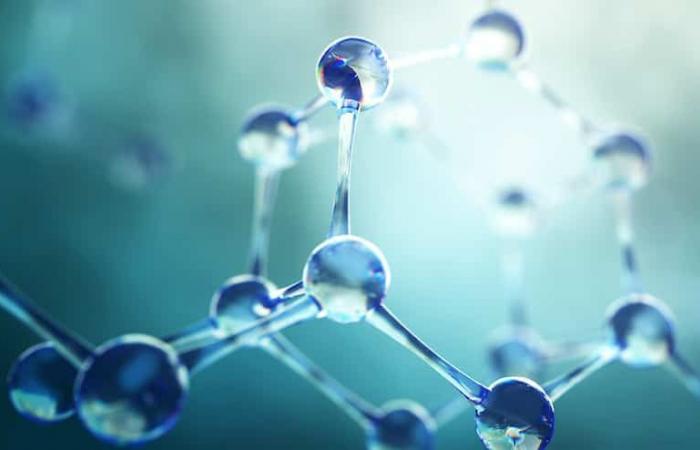A major biochemical study reports that neuropilin-1, a receptor expressed on the surface of several types of cells, facilitates infection with the coronavirus and could therefore represent an interesting new therapeutic target for the development of drugs against COVID-19.
In order to infect human cells, the coronavirus SARS-CoV-2 responsible for COVID-19 must first attach to their surface, which subsequently allows it to enter the cells and leave. reproduce there.
Understanding the biochemical mechanisms that govern this interaction of the virus with cells is therefore at the heart of efforts to develop antiviral therapies and vaccines capable of neutralizing the virus to put an end to the current COVID-19 pandemic.
Cut to better infect
It was quickly discovered that the virus’s interaction with the cell surface was mediated by a protein present in its spicules, the peak-like structures that line the exterior of the coronavirus.
This protein (called protein S) has a very strong affinity for a receptor called ACE2, present on the surface of human cells and the interaction with this protein facilitates the translocation of the virus inside cells.
A unique feature of the SARS-CoV-2 protein S is the presence of a basic amino acid sequence (RRAR, i.e. Arginine-Arginine-Alanine-Arginine) which is not found in other coronaviruses, including its close cousin SARS-CoV-1, responsible for the 2002 SARS epidemic.
Since the current coronavirus is much more contagious than other coronaviruses, this sequence has been proposed to play a key role in its infectious potential and high rate of transmission. 1.
The mechanism involved is very elegant (and very complicated!): The basic amino acid sequence present in protein S is recognized by the furin protease, a molecular scissor which cuts the protein at this point and generates two segments, called S1 and S2.
The S2 portion is subsequently cut by another protease (TMPRSS2) which facilitates its interaction with ACE2 and the entry of the virus into the cell. 2.
Additional entrance door
The basic amino acid sequence RRAR, present at the end of the S1 fragment following the cleavage by furin, corresponds in every way to a molecular motif known to interact with neuropilin-1, a receptor present on the surface. of several cells.
According to a study recently published in the prestigious Science, this association of the virus with neuropilin could provide the virus with an additional entry point and therefore contribute to its infectious potential 3.
Using biochemical, genetic and X-ray crystallography approaches, the researchers clearly showed that the S1 fragment does interact with neuropilin-1 via the RRAR motif generated as a result of furin cleavage.
More importantly, they observed that blocking this interaction with antibodies specifically directed against neuropilin-1 abolished the interaction with the S1 fragment and significantly reduced the infection of cells with the coronavirus.
As mentioned by the authors, the interaction of neuropilin-1 with proteins containing an RRAR-like motif is known to facilitate the entry of these proteins into cells by the process of endocytosis.
It therefore seems likely that a similar phenomenon will occur following binding to the S1 fragment of the coronavirus, which could explain, at least in part, the very high infectious potential of this virus.
It is also interesting to note that a natural mutant of SARS-CoV-2, lacking the furin cleavage site and therefore not being able to interact with neuropilin-1, is much less virulent. 4.
At present, most of the therapeutic approaches developed against the coronavirus target the virus as such, for example with the help of antibodies and vaccines that block its binding to cells.
The results of the study suggest that neutralizing the portal of entry used by the virus, in this case neuropilin-1, could prove to be a complementary strategy for the development of drugs against COVID-19.
Understanding the molecular mechanisms involved in this infection is essential if we are to win the war against this virus.
◆ Coutard B et al. The spike glycoprotein of the new coronavirus 2019-nCoV contains a furin-like cleavage site absent in CoV of the same clade. Antivir. Res. 2020; 176 : 104742.
◆ Hoffmann H et coll. SARS-CoV-2 cell entry depends on ACE2 and TMPRSS2 and is blocked by a clinically proven protease inhibitor. Cell 2020; 181 : 271–280.
◆ Daly JL et al. Neuropilin-1 is a host factor for SARS-CoV-2 infection. Science, published on October 20, 2020.
◆ Lau SY et al. Attenuated SARS-CoV-2 variants with deletions at the S1/S2 junction. Emerg. Microbes Infect. 2020; 9 : 837–842.
*We just want readers to access information more quickly and easily with other multilingual content, instead of information only available in a certain language.
*We always respect the copyright of the content of the author and always include the original link of the source article.If the author disagrees, just leave the report below the article, the article will be edited or deleted at the request of the author. Thanks very much! Best regards!
These were the details of the news A new molecular gateway for the coronavirus for this day. We hope that we have succeeded by giving you the full details and information. To follow all our news, you can subscribe to the alerts system or to one of our different systems to provide you with all that is new.
It is also worth noting that the original news has been published and is available at en24news and the editorial team at AlKhaleej Today has confirmed it and it has been modified, and it may have been completely transferred or quoted from it and you can read and follow this news from its main source.

